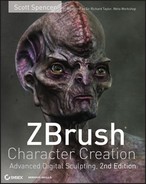In this section we’ll explore the ZBrush sculpting tools by creating a lion head door knocker from a 3D Plane tool. This tutorial will expose you to many of the ZBrush sculpting brushes, modifiers, and masking tools.
In ZBrush you can work with models, tools, or documents. For sculpting characters we’ll focus on tools and models. When creating final rendered images in ZBrush, we’ll make use of the Document settings.
Creating a 2.5D Pixol Illustration
ZBrush works with essentially three types of objects: models, ZTools, and documents. Models are geometry that either you create in ZBrush using primitives and ZSpheres, or obj models imported from third-party applications like 3ds Max or Maya. These models can then become tools when you begin to subdivide and sculpt or paint on the surface. ZTools are a ZBrush file type for storing 3D models with multiple levels of subdivision as well as texture information. Documents are essentially images. Documents are a hybrid between painting and rendering. You can place your ZTools in the document space, and light, shade, and render them as a 2.5D illustration.
2.5D illustration is a ZBrush term for an illustration tool that allows you to paint color, materials, and depth. The ZBrush canvas is “depth enabled,” which gives ZBrush its powerful image-creation capabilities.
The ZBrush workspace is called the document window. This is where you’ll sculpt and paint your characters. The document window has many powerful and unique aspects that are often overlooked when you are not using ZBrush as a purely illustration or concept design tool.
The artist can “drop” tools in the document window, interactively lighting and shading them in 2D. You can even continue to sculpt on your illustration. Although many of the document-based tools are not useful to a production environment outside of the art department, I feel it is important to cover them here as they form the basis of ZBrush’s toolset and influence how many of the tools and menus behave.
Documents can make use of layers as well as interactive lighting and rendering, but documents cannot be rotated and edited in 3D space; they are composed of pixols. Pixols are special pixels that carry color information as well as depth and material data.
For the purposes of sculpting and painting characters, we typically do not use the document settings, but there are cases where these tools will come in handy. Some brushes, especially those we use in the Projection Master plug-in, are document based, so it is important to understand the distinction between documents and tools as well as know how to use them effectively together.
The purpose of this tutorial is to introduce you not only to sculpting in ZBrush but to the different methods of working in the program. While making this door knocker we’ll be using primitives, the standard sculpting tools, alphas, and brush strokes. First we’ll use ZBrush primitives to sculpt and assemble the door knocker.
Sculpting a Lion’s Head
You will begin by sculpting the lion head. For the lion bas-relief we’ll use a ZBrush primitive, the Plane3D tool.
I want to remind you that I am constantly moving the ZTool as I work, sculpting from all angles. You can see this in the video captures of the tutorial sessions provided on the DVD with this book.
1. Under Tool, click the active tool icon and select Plane3D. Click and drag on the canvas with the left mouse button to draw the tool.
2. Before you can edit this, you need to enter Edit mode. Press T on your keyboard or click the Edit button at the top of the screen (Figure 1-18).
Figure 1-18 Edit mode can be accessed via this button at the top of your screen or by pressing the T key.

3. To change materials, open the Material menu. ZBrush has several default materials available to you. Typically I use the MatCap White Cavity shader over the default red wax. The translucency in red wax makes spotting surface form a little tricky. Click the Current Material box at the left of the screen or under the Material menu to open the Material Palette window. From this palette select the icon swatch for the material you prefer. For this tutorial I used the White Cavity shader. It is under MatCap Materials in the Material Browser.
If you neglect to enter Edit mode after drawing a model on the canvas, ZBrush will continue to add copies to the document window, dropping each one on the canvas as you go.
4. The plane is now in Edit mode, but this is a ZBrush primitive and not a polymesh. Polymeshes are polygonal 3D models that can be subdivided and sculpted inside ZBrush. Models imported into ZBrush are polymeshes by default, but meshes we create from primitives need to be converted with the Make PolyMesh3D button under the Tool menu. This converts the ZBrush primitive into a polymesh, which we can now use to sculpt on.
At this stage, let’s activate sculpting symmetry. This allows you to sculpt one side of the lion’s face while the other side automatically mirrors your changes. To turn on Symmetry, press the X key on the keyboard to activate X Symmetry. X Symmetry will mirror your sculpting actions across the center line of the figure. The Symmetry options are located on the Transform menu at the top of the screen. To access the options, select Transform Activate Symmetry. You’ll see a red dot on the other side of your model that mirrors your brush strokes. It is generally a good idea to start a sculpture with Symmetry turned on. Always turn off Symmetry in the final stages to add another level of realism by breaking the perfect balance between the forms or adding little differences between the sides.
At this time you may also turn on Perspective Camera. By default ZBrush uses an orthographic camera, but if you want a view that is more natural, click Draw Persp to activate the perspective view. The focal angle can be adjusted with the Focal Angle slider. The Floor button will activate a floor grid that displays in the document window. This can be useful for finding your orientation when working with modifiers that take an X, Y, or Z setting, such as those under the Tool Deformation menu. You may also activate a grid for each axis that can be used when mirroring and merging geometry.
5. You may now sculpt on the surface of the plane. At the top of the screen select the Brush menu and tear it off with the circle icon so it docks to the side of the screen for easy access. Click the active tool icon and select the Standard brush. You want to make sure Stroke is set to Freehand and that Alpha is turned off. Set Draw Size to about ¼ the plane size and leave Focal Shift at 0 and ZIntensity at 20. Your Brush, Alpha, and Stroke settings can also be accessed via the left screen menu.
6. Click and draw on the model surface now, and you will see it begin to pull at the polygons. The effect is faceted because we are currently at the lowest subdivision level (Figure 1-19). You can add geometry by subdividing the model once with Tool Geometry Divide to add one subdivision level.
Figure 1-19 When sculpting at lower subdivision levels, the strokes will appear faceted.

7. Begin to block in the basic form of the lion head (Figure 1-20). Remember to add as well as subtract with your brush and rotate often around the shape. Don’t get overwhelmed with making little details at this stage. Instead, establish the primary forms of the lion’s face and their positions in relation to each other.
Figure 1-20 Shape roughed in from front and side
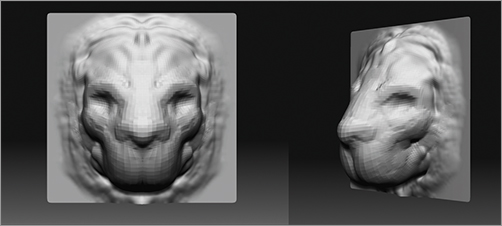
To add a subdivision level use Ctrl+D; to step up your subdivision levels, press D; to step down, press Shift+D.
This is easier to do by moving often and working the entire sculpture at once. If you spend too long in one view, the sculpture tends to flatten out. If you sculpt entirely from one view, it may look great until you move the model. A single view can be misleading. Looking at the sculpt in Figure 1-21, it is difficult to perceive the flattening, which is obvious when viewed from the side. This is why you want to be sure to rotate often while you work. Figure 1-22 shows how I corrected the flattening from the top view.
Figure 1-21 Objects may look fine from the front while lacking depth when viewed from other angles.

Figure 1-22 The flat face from top and corrected face from top
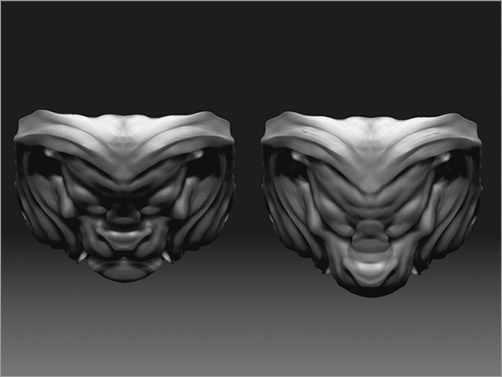
Don’t neglect looking at the sculpture from the top and bottom. Typically the viewer won’t see it from such an extreme view, but it helps you quickly identify whether the forms of the face are flattening out or turning nicely in space.
8. While working, establish the forms that are advancing in space, like the snout and brows, as well as those that recede, such as the eye sockets and mouth. You can cut in with your brush by clicking the ZSub button at the top menu bar or by simply holding down the Alt key while you sculpt.
9. To quickly bring the faces of the snout forward and create depth in the head, in a three-quarter view use the Move brush (Figure 1-23). The Move brush will grab and pull vertices underneath the draw radius. Use the Intensity slider to increase the strength of the move. I also use the Move brush to pull the points of the square plane into silhouette with the outline of the lion’s mane.
Figure 1-23 Pulling the snout forward from the top and side views

Mouse Average, LazyMouse, and Trails
Under the Stroke menu you will find several options that affect how your brush is drawn across the surface of the sculpture. The Freehand stroke is the most widely used as it behaves like a paintbrush tool in Photoshop. Mouse Average is used to average the instances of each alpha as you stroke along the surface. This can reduce “stuttering” in the stroke or dotting when working at higher subdivision levels. When working on lower levels, keep this set to 1.
Also in this menu you will find LazyMouse. LazyMouse is another averaging utility that delays your pen stroke so it appears at the end of a red line extending from your brush center. This is very useful when you’re trying to sculpt long, sweeping curves that might otherwise be extremely difficult to achieve freehand. The image here illustrates the differences in these two stroke options; the staggered stroke on the left was created without LazyMouse, and the smoother stroke on the right was drawn with LazyMouse.

LazyMouse has several new options to help create different kinds of strokes. These are found in the LazyMouse menu. Press the Backtrack button to activate these other options. Backtrack allows you to conform your stroke to a plane, line, spline, or path. We will address these settings more later in this book.
The Trails option is another method of smoothing the brush stroke. Located under the Brush Modifiers menu, Trails creates multiple instances of your brush stroke, helping to smooth the resulting lines, especially when you are sketching quickly with a small brush size. Trails can be useful for creating some types of wrinkles at a very high subdivision level. It accomplishes this by eliminating the staggered dotting you will often get when using a small brush size at a high subdivision level. See the DVD for a video demonstrating LazyMouse versus trails.
Everyone uses the sculpting tools differently. You find the combination that works for you through experimentation and emulation. Sketching character heads or faces on primitive spheres and planes makes for great practice.
You can quickly select brushes by using the built-in brush hotkeys. Press the B key to bring up the complete Brush menu. Next, press the first letter of the brush you want. For example, press M if you want Move. This hides all the brushes except the ones that begin with the letter M. Notice that each brush icon now has an orange letter. This represents the hotkey for that brush. Press the V key to select Move. With a little practice, this navigation system can become your favorite way to select brushes in a snap.
At this stage you can add another subdivision level to allow yourself more material to sculpt on. Continue to use the Standard, Inflate, and Clay brushes to define the head and mane. Notice that I am stroking in a general direction for the sculpted hair as I mass out its form (Figure 1-24).
Figure 1-24 Progress shots
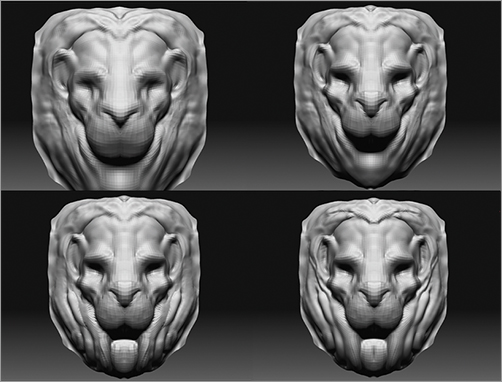
At this point I begin to carve away the recess where the ring will fit into the lion’s mouth (Figure 1-25).
Figure 1-25 Sculpting a recessed area for the ring to sit

Adding Subtools
Now that the basic form of the lion is established, let’s add the ring to his mouth. Adding the ring at this stage will allow us to sculpt the forms of his mane and mouth around the ring so it appears that the two parts are interacting.
1. To add a subtool, you must append it into your current ZTool. Save your ZTool and then return to the Tool menu. Select the current tool icon and pick the Ring3D tool. Once again we are dealing with a ZBrush primitive and not a polymesh. Although an object is a primitive, we cannot sculpt but we can change the object’s parameters. In the case of the ring, we want to make it smaller. Select Tool Initialize, and change the ring’s SRadius setting to 21 (Figure 1-26).
Figure 1-26 The Initialize menu allows you to change aspects of the ZBrush primitives before they are converted to polymeshes.
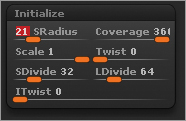
2. To make this ring ready for inclusion with the rest of the lion head, convert it to a polymesh. Click the Tool menu at the top of the screen and click the Make PolyMesh3D button. If you simply wanted to add a ring to the Lion head ZTool without making any changes to the ring, the process is simple. With the lion head selected, click Tool Subtool Append and select the Ring tool. ZBrush will automatically convert it to a polymesh and add it to the subtool stack.
3. To add this to the lion head as a subtool so you can manipulate both models on screen at once, you must append it to the current tool. At the top of the screen click Tool Subtool. In the Subtool menu is a button marked Append; click it and a fly-out menu will appear listing all the currently loaded ZTools. From this menu select the Lion tool. This will add the Lion ZTool as a subtool to the ring (Figure 1-27). Subtools combine multiple ZTools together into one, allowing you to sculpt and manipulate each separately while retaining their positional relationship to each other. Later in this book we’ll use subtools for placing eyes and other accessories into a character while retaining multiple levels of subdivision on each tool.
Figure 1-27 Clicking the Append button will open a menu from which you can select the tool you want to add as a subtool.

The ring should now be centered in the lion’s head. It must be moved down into the mouth area we created for it. There are three methods of moving objects and faces in ZBrush that are useful for different tasks (described in a moment). To move the ring, we’ll use the Transpose tools (Figure 1-28).
Figure 1-28 Using the Transpose tool

Navigating Subtools
You can sculpt on only one subtool at a time. To set your active subtool, select it under the Subtool menu. Or you can Alt+left-click the object in the document window to activate that subtool.
To toggle subtool visibility, use the eyeball icon. You can set visibility on any subtools, active or not. To show all subtools, click the eyeball icon on the active tool to hide all but the current subtool. Ctrl+Shift-click the subtool in the Subtool list.
4. Enter Transpose mode by pressing W. You will now have a transpose line on the screen. Click on the 3D ring and drag to a point on the canvas to draw a new transpose line (Figure 1-29). Because we are in Move mode at the top of the screen, this will allow us to move the ring. Notice that there are two other buttons, for Scale and Rotate. If these buttons are active, the transpose line will scale or rotate the ZTool instead of moving it. The transpose ring can be repositioned by clicking on the line itself; to move an endpoint, click on one of the three circles. To use the transpose line to manipulate the currently selected subtool, click inside one of the three circles and drag with the mouse.
Figure 1-29 Ring with transpose line click and drag in the center of the indicated circle to move the ring.

When you are in Transpose mode, hover your mouse over each circle. The function of the circle will be displayed in the upper-left corner of the screen. For example, in Move mode the outer circles will stretch the model while the center circle moves it relative to other subtools or the document window. Once you understand the transpose line, you can use a shortcut to enter it (or Scale mode) and instead of drawing the line, simply Alt-click and drag on the model. It will move or scale the subtool as if you were clicking in the center circle.
5. Click in the center circle and drag. You can see how the Ring3D tool can be easily moved and placed in space. If you need to move it back from your view, simply rotate the model so you are looking down on it. Place it approximately in the lion’s mouth. We’ll use the Move brush to adjust the shape of the mouth to better grip the ring (Figure 1-30).
Figure 1-30 Moving the mouth into position with the Move brush

Moving in ZBrush
“Moving” in ZBrush can refer to moving ZTools in relation to each other, moving in relation to the canvas, or moving polygons as a group with a brush. There are three methods of moving inside ZBrush:
Transpose Designed for posing models or moving subtools in relation to one another.
Move Brush Moves polys and faces with a brush when sculpting large forms. It is used to move parts of a model to changes its shape. There are several variations on the Move brush, including Move, Move Elastic, Move Topological, and Move Parts.
Document Move Gyro Moves objects in relation to the canvas. This is rarely used except in ZBrush illustration.
Refining Your Model
Now that we have roughed in the lion head and placed a subtool, we can begin to refine the forms of the sculpture overall. In this section we’ll continue to use the sculpting brushes to make the rough shapes relate to each other and create a sense of rhythm in the forms. Before we start, let’s take a moment to look at some of the new tools and modifiers we’ll use in this section, specifically the LazyMouse Pinch brush and Brush Modifier sliders.
1. At this stage, let’s develop the mane. Add another subdivision level by pressing Ctrl+D. There will be a level of stylization to the planes of the hair. We want to create sweeping arcs that transition from the top of the head to the chin. To create smooth-flowing strokes like this with hard edges, use the Pinch brush. Select the Pinch brush and set your Brush Modifier slider to 60 and your ZIntensity to 15 (Figure 1-31). As you stroke along the surface, notice how it pulls the edges together and up (Figure 1-32).
Figure 1-31 The Brush Modifier slider

Figure 1-32 The cross sections show the Pinch brush stroke with different Brush Modifier settings.

If you set the Brush slider to -60, the inverse happens: it presses in while it pinches. I keep the slider at 60 and use the Alt key to invert my stroke to press in when needed.
2. You can further control the sweep and smoothness in the strokes of the mane by using the LazyMouse option. This technique will average the stroke and help you create a sweeping line. Press the L hotkey or select Stroke LazyMouse (Figure 1-33).
Figure 1-33 The LazyMouse button on the Stroke menu
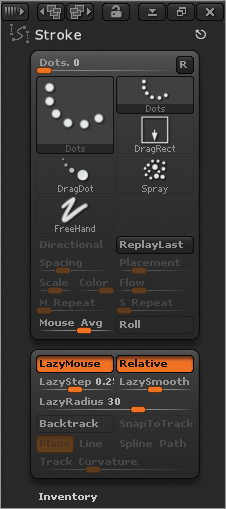
The red line that trails slightly behind your stroke is the center of the influence (Figure 1-34). This delay built into the LazyMouse stroke is what allows you to make long sweeping motions with the brush tools that would otherwise be difficult, if not impossible, with an unassisted freehand approach.
Figure 1-34 LazyMouse in use. Notice the red action line, which offers visual feedback on where the effect of the stroke is on the surface.
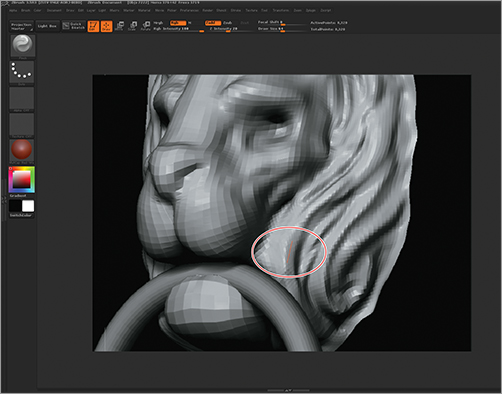
There are many options you can use in conjunction with LazyMouse to get nice sweeping curves or sharp, crisp straight lines. Please see the DVD for video of LazyMouse in action.
3. With the ring in place, return to Draw mode by pressing Q. Change the selected subtool from the ring back to the lion head (by selecting the subtool from the Tool Subtool menu or by Ctrl+Shift-clicking the lion head in the document window). You will notice the lion head becomes a lighter shade when selected.
4. Select the Move brush from the brush palette and tumble to a side view. Adjust your draw size and pull the lower jaw up and around the ring (Figure 1-35). If the Move tool isn’t working strong enough, raise your ZIntensity slider to increase its power. You may also want to turn on subtool transparency with the Transp button at the right side of the screen. This allows you to see through subtools in front of your active tool but also allows your tool to sculpt through to the hidden surface.
Figure 1-35 The mouth and mane sculpted to flow around the ring

5. Continue to pull strokes in the mane, keeping in mind the gesture of the lines and how they flow down into the ring. Keep looking for the overall graphic quality of the shapes and try to maintain a visually appealing rhythm. When using LazyMouse for a long fluid stroke, set your ZIntensity lower than necessary and use the Replay Last command to repeat your stroke, building up to the form you want by repeating. Replay Last is found on the Stroke menu, or use the number 1 key at the top of the keyboard which is the shortcut. Each time you use Replay Last, the same stroke repeats and thus builds up its effect on the surface.
Some of the deep recesses could benefit from being tightened. Doing this from the front of your sculpture can sometimes be tricky if the area you want to tighten is small or close to other details you want to remain unchanged. Often you will pinch the faces on either side and inadvertently change areas you wanted to remain unchanged. Masking into tight areas can also sometimes be a challenge. One unique solution in ZBrush is to sculpt from inside the model as well as the outside.
6. Select Tool Display Properties and click the Double button to activate double-sided rendering (Figure 1-36). Now when you rotate around the back of the lion head, you can sculpt from the inside (Figure 1-37). This is very helpful in tight areas like the creases in the hair or the eyelids.
Figure 1-36 The Double button in the display options allows you to turn on double-sided rendering in the display.

Figure 1-37 Sculpting from the back

7. From the front, draw a masking line by Ctrl-clicking and dragging to mark the area you want to pinch. This is just a visual note so the same area can be seen easily from the inside. Masking displays on both sides of a face (Figure 1-38).
Figure 1-38 With double-sided rendering on, you can sculpt from inside the model as well as outside for reaching tight areas. (The right image shows the mask stroke as seen from the back of the mesh.)

8. Rotate to the back and locate your masked line. Clear the mask by Ctrl-dragging on the document window or by choosing Tool Masking Clear and using the Pinch brush to deepen and sharpen the line. Use a Brush Modifier setting of 60 and a small Draw Size and Focal Shift of 0. I also use the Pinch brush to refine the planes in the head. I want to add a stylized planar feel to the lion’s face while still maintaining the character of a lion.
9. To sculpt eyes directly into this mesh, begin with the Inflate brush at a low intensity and build up the spherical shape of the eyeball (Figure 1-39).
Figure 1-39 Inflating the eyeballs from the mesh

You can mask out areas you don’t want to affect with your strokes by pressing the Ctrl key. Your cursor turns yellow to let you know you are in Masking mode. To paint out part of a mask, use Ctrl+Alt-click. To mask large areas, Ctrl-click outside the model and drag a masking rectangle. Also experiment with the Lasso tool for making more specific and complex mask selections. Select Mask Lasso from the Brush menu. The Lasso mode alters the way masks are drawn. Instead of a single rectangle, you can draw a lasso around the desired area freehand. The masking effect will be mirrored if Symmetry is on.
Adding the eyes is easy with masking. Select the MaskPen brush and, while holding down Ctrl, draw a mask in the shape of the eyelids over and around this basic sphere shape. Once the shape of the exposed eye is masked in, you can invert the mask by Ctrl-clicking the document window somewhere off the model (Figure 1-40).
Figure 1-40 Using masking to help sculpt an eye from the mesh

Your eye is now unmasked while the rest of the head is masked. Use the Move brush from the side view to pull the eye in slightly. This will create the thickness of the eyelids. Using the Inflate brush, build out the sphere of the eyeball and corneal bulge.
10. Ctrl-click off the model to invert the mask so the eye surface is masked. Refine the edge of the eyelid with the Standard brush and LazyMouse, adding some thickness here.
While you sculpt, be sure to move between the subdivision levels. Always work at the lowest level that can support the form you are trying to add. If you sculpt the entire time at the highest level, it becomes very hard to make big changes to the shape without creating a lumpy surface.
11. With the Pinch brush and LazyMouse on, pinch the outer edge of the eyelid (Figure 1-41). Be sure to reduce your draw size. At this stage, I also pinch in using the Alt key to add some subtle wrinkles around the upper eyelid and indicate the furrow at the bottom of the eye where the sphere of the eyeball dips into the skull.
Figure 1-41 Pinch the eyelids to crease them and create sharper transitions. Notice the thickness added to the eyelids in step 10.

12. Pinch the inner edge closest to the eyeball (Figure 1-42). Hold down Alt to pinch in instead of out. Add the medial canthus of the eye and tear duct with the Standard brush. Mask out the little dot of skin in the corner of the eye to create the membrane. Invert the mask and inflate slightly with a low intensity.
Figure 1-42 Pinching the inner eyelid edges

Finishing Your Model
The following list represents some of the edits made to this sculpture to bring it to completion:
- Added the tear duct to the eyes. These little details are extremely important, even on a stylized eye such as this.
- Raised the ears higher on the head to give a more feline appearance.
- Increased the slope in toward the jaw and pulled the side curls out at an angle. While I made these edits I was looking for a visually pleasing stylization to the lines in the head and hair. The gesture of the curves implied by the mane leads your eye in a figure-8 around the sculpture.
Creating a 2.5D Pixol Illustration
At this stage, the basic sculpture of the lion’s head is complete, but so much more is possible here. If you would like to see how this sculpture is incorporated into a 2.5D illustration—with additional details like a backing plate and with the door textured and stained—please see the DVD for a PDF file that continues this project as an illustration (Figure 1-43). I encourage you to look at this material since ZBrush is a powerful illustration tool and many of its sculpting techniques are built on this foundation.
Figure 1-43 The final 2.5D illustration created in the bonus section on the DVD. By sculpting the lion head knocker as a 3D object and combining it with canvas elements, you can create a complex scene.

These techniques are useful to the digital illustrator as well as when conceptualizing a character with ZBrush. Even though you can export your work to external renderers for animation and rendering, I wanted to show the power of ZBrush as a rendering and illustration tool in itself. These are often overlooked aspects of the program, but they are powerful tools to have in your arsenal even if you never do 2.5D illustration. Many of these tools are usable on 3D models in Edit mode using the Projection Master script. Projection Master will allow you to blend 3D sculpting with the 2.5D tools to create highly detailed models for export to other applications. In Chapter 2, “Sculpting in ZBrush,” we’ll take an in-depth look at sculpting a bust in ZBrush.
